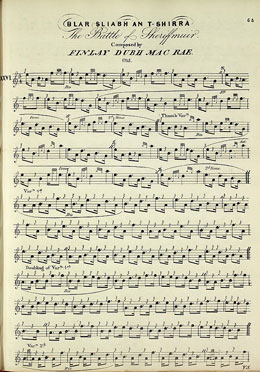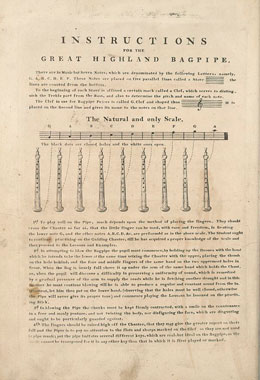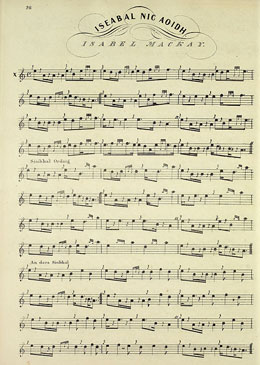Instruments : The Bagpipe


The bagpipe is globally the most recognised Scottish instrument. Its beginnings go back to at least medieval times in Scotland but bagpipes of various shapes and sizes have existed in many countries for many centuries going as far back as ancient times.
Types of bagpipes in Scotland
The two main types of bagpipes in Scotland are the great Highland bagpipe and the small Lowland or border bagpipe. It is the great Highland bagpipe, pìob mhòr, that is associated with the great Highland tradition of piping in the Gàidhealtachd and in particular the hereditary pipers on the isles. There are also smaller versions of the great Highland bagpipe, pìob bheag, used indoors and for dancing, and the lowland or border bagpipes.
The use of the bagpipe
Gaelic clan chiefs employed pipers in various roles, mainly to lead men into battle and to play for formal occasions like funerals. This changed after the demise of the clan system following the Jacobite rebellions when the function changed to less formal occasions which is still the case today. Much of the music heard in public is ‘light’ or ‘small’ music, that is music consisting of popular tunes, suitable for marching, dancing etc. The ‘big’ or ‘classical’ music for the bagpipe is heard more often in formal settings and is prominent at competition level and special occasions.
Ceòl Beag (‘Small’, ‘little’ or ‘popular’ music)

The ‘small’, ‘little’ or ‘popular’ bagpipe music is historically comprised of airs and dance music forms such as strathspeys, reels, jigs, marches, quicksteps and song tunes. It is also the music you are most likely to hear performed in the street and on popular occasions by both solo pipers and pipe bands, often adapting popular tunes like ‘Caledonia’ or even modern pop tunes.
'Glen’s collection for the great highland bagpipe' contains ‘small’ music and is a popular 19th century collection published by bagpipe makers John and Robert Glen. Library shelfmark: Cam.1/g/16 (1890/1900 ed).Ceòl Mòr (‘Big’ or ‘classical’ music)

The ‘big’, ‘great’ or ‘classical’ music for the bagpipe, or more specifically the great Highland bagpipe, is a more complex music that is composed and follows a more formal structure. The music, also referred to as ‘piobaireachd’ or ‘pibroch’ has been handed down generations of piping families such as the MacCrimmons, hereditary pipers to the MacLeods of Dunvegan.
Bhiodag Bhoidheach
The main types of ceòl mòr include:
- the salute
- the gathering
- the lament
In addition to these, there are also battle tunes such as the 'Battle of Sheriffmuir/Blar Sliabh an t-shirra' (Library shelfmark: Glen.354).
The main forms of the ceòl mòr follow this basic structure containing an air with a variation of movements:
- Ùrlar (ground, that is a basic slow version of a tune containing the theme of the tune)
- Siubhal, or Dithis (the first variation on the theme)
- Taorluath (another variation at a quicker tempo)
- Crunluath (quick finishing movement returning to the original air or tune)

Each of these main sections contains further subsections, usually in the form of doublings or repetitions.
There are several instruction books, called tutors, in the National Library collection, some of which are included in collections of pipe music such as Donald Macdonald’s ‘Collection of the ancient martial music of Caledonia, called Piobaireachd’ (Library shelfmark: Glen.298).
Piping today
Piping today is popular in many areas:
- Busking in the streets (usually solo pipers playing popular tunes i.e. ‘small’ or ‘light’music)
- Marching pipe bands (mostly ‘small’ or ‘light’music)
- Formal occasions like weddings and funerals (here the music can be ‘big’ or ‘small’)
- Competitions and festivals (for example the World championships, Piping Live)
- Educational activities (including those at the College of Piping and the National Piping Centre in Glasgow)
Forms of notation of bagpipe music

Western style staff notation has been adapted to allow bagpipe music to be shared more widely. This tune, ‘Murt Ghlinne a Comhann’ from ‘A collection of ancient piobaireachd or Higland pipe music…’ (Library shelfmark: Glen 354) is an example of what this adaptation looks like).
Canntaireachd
The definition of Canntaireachd in an article reproduced on The Piobaireachd Society website states:
The word “Canntaireachd” means “singing” in Gaelic, but rather than this general definition, for pipers it has come to mean the singing of Piobaireachd.
The Oxford dictionary of music describes canntaireachd:
“as curious Scottish bagpipe notation, in which syllables stand for recognised groups of notes”.
Canntaireachd uses a system of vowels and consonants representing notes of the tune and its variations in such a way that it can be sung and used to teach bagpipe tunes. Even today traditional teachers still use the system.
A significant piece of canntaireachd in the Library collections: The 'Gesto Canntaireachd'
Pipers trace their art of pibroch back to the legendary family of bagpipers, the MacCrimmons, on the Isle of Skye. John, also known as Iain Dubh MacCrimmon lived in Skye until 1822. From him, Neil MacLeod of Gesto, a local laird and piping enthusiast, noted down the canntaireachd, and published 20 of the pieces in 1828.


By comparison, this is a standard notation version of the tune as published in 1838 in 'A Collection of Ancient Piobaireachd or Highland Pipe Music' by Angus Mackay (Library shelfmark Glen.354).
The Library’s copy of the Gesto Canntaireachd had belonged in turn to Sir John Graham Dalyell, and John Francis Campbell of Islay, two leading figures in the history of Highland music and tradition. Its value is greatly enhanced by an autograph manuscript of notes on the tunes by Neil MacLeod - a document which was long thought to have been lost.
Further Reading and other resources
For a full reading list visit the Learning resources page.
- Robert Menzies (Capt). The Bagpipe Preceptor; or, The art of playing the great Highland bagpipe rendered perfectly easy to every capacity ... To which are added a few favourite simple airs, etc. Edinburgh: Oliver and Boyd, 1818. Library shelfmark: Mus.Box.q.59.4
- Tom and Valerie Byran. Ullapool. Music of Lochbroom and Coigach - past and present. 1988. Library shelfmark: Mus.D.s.59
- William Bryson. The Edcath collection of Highland Bagpipe music. Compiled by William Bryson. Book 3. Edinburgh: Hugh Macpherson, 1968. Library shelfmark: Mus.Box.q.180.5
- Archie M Cairns Pipe Major. Canadian Forces Pipe Band Manual. Compiled /composed / arranged by Pipe Major A H Cairns and Master Warrant Officer J B Kerr. Department of National Defence: Ottawa, 1979. Library shelfmark: MH.183